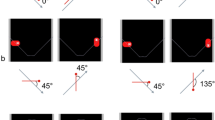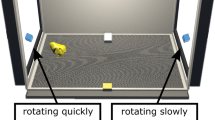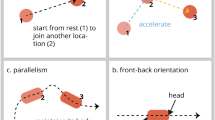Abstract
To examine the effects of early visual experience on preference for biological motion (BM), newly hatched chicks were exposed to a point-light animation (a visual stimulus composed of identical light points) depicting the following features of a hen: a walking hen (a BM stimulus), a rotating hen (a non-BM stimulus), a pendulum stimulus, a random motion stimulus and a stationary pattern. Chicks were then tested in a binary choice task, choosing between walking-hen and rotating-hen stimuli. Males exhibited a preference for BM if they had been trained with any animation except the stationary pattern stimulus, suggesting that the BM preference was not learned, but induced by motion stimuli. We found a significant positive correlation between the number of approaches in training and the preference in the test, but locomotion alone did not cause preference for BM. In contrast, females exhibited a particularly strong preference for walking-hen stimuli, but only when they had been trained with it. Furthermore, females (but not males) trained with random motion showed a preference for walking hen over walking cat (a biological motion animation depicting a cat), possibly suggesting that females are choosier than males. Chicks trained with a stationary pattern and untrained controls did not show a significant preference. The induction of BM preference is discussed in terms of possible ecological background of the sex differences.




Similar content being viewed by others
References
Bateson P (1979) How do sensitive periods arise and what are they for? Anim Behav 27:470–486
Blake R (1993) Cats perceive biological motion. Psychol Sci 4:54–57
Brown J, Kaplan G, Rogers LJ, Vallortigara G (2010) Perception of biological motion in common marmosets (Callithrix Jacchus): by females only. Anim Cogn 13:555–564
Casile A, Giese MA (2006) Nonvisual motor training influences biological motion perception. Curr Biol 16:69–74
Dittrich WH, Lea SEG, Barrett J, Gurr PR (1998) Categorization of natural movements by pigeons: visual concept discrimination and biological motion. J Exp Anal Behav 70:281–299
Dunnington EA, Siegel PB, Gross WB (1986) Sex-linked feathering alleles (K, k+) in chickens of diverse genetic backgrounds. Avian Pathol 15:139–148
Fridolfsson A, Ellegren H (1999) A simple and universal method for molecular sexing of non-ratite birds. J Avian Biol 30:116–121
Hess EH (1958) “Imprinting” in animals. Sci Am 198:81–90
Hess EH (1959) Imprinting. Science 130:133–141
Horn G (2004) Pathways of the past: the imprint of memory. Nat Rev Neurosci 5:108–120
Izawa E, Yanagihara S, Atsumi T, Matsushima T (2001) The role of basal ganglia in reinforcement learning and imprinting in domestic chicks. NeuroReport 12:1743–1747
Johansson G (1973) Visual perception of biological motion and a model for its analysis. Percept Psychophys 14:201–211
Johnson MH, Horn G (1988) Development of filial preferences in dark reared chicks. Anim Behav 36:675–683
Johnson MH, Bolhuis JJ, Horn G (1985) Interaction between acquired preferences and developing predispositions during imprinting. Anim Behav 33:1000–1006
MacKinnon LM, Troje NF, Dringenberg HC (2010) Do rats (Rattus norvegicus) perceive biological motion? Exp Brain Res 205:571–576
Matsushima T, Izawa E, Aoki N, Yanagihara S (2003) The mind through chick eyes: memory, cognition and anticipation. Zool Sci 20:395–408
McBride G, Parer IP, Foenander F (1969) The social organization and behavior of the feral domestic fowl. Anim Behav Monogr 2:127–181
Parron C, Deruelle C, Fagot J (2007) Processing of biological motion point-light displays by baboons (Papio papio). J Exper Psychol Anim Behav Proc 33:381–391
Regolin L, Tommasi L, Vallortigara G (2000) Visual perception of biological motion in newly hatched chicks as revealed by an imprinting procedure. Anim Cogn 3:53–60
Simion F, Regolin L, Bulf H (2008) A predisposition for biological motion in the newborn baby. PNAS 105:809–813
Tamura C, Takahashi T, Tanaka M (1987) Effects of late feathering gene on growth, laying performance and egg qualities. Bull Takikawa Anim Husb Exp Stn 23:29–34 (in Japanese)
Tomonaga M (2001) Visual search for biological motion patterns in chimpanzees (Pan troglodytes). Psychologia 44:46–59
Vallortigara G (1992) Affiliation and aggression as related to gender in domestic chicks (Gallus gallus). J Comp Psychol 106:53–57
Vallortigara G, Regolin L (2006) Gravity bias in the interpretation of biological motion by inexperienced chicks. Curr Biol 16:R279–R280
Vallortigara G, Regolin L, Marconato F (2005) Visually inexperienced chicks exhibit spontaneous preference for biological motion patterns. PLoS Biol 3:1312–1316
Workman L, Andrew RJ (1989) Simultaneous changes in behavior and in lateralization during the development of male and female domestic chicks. Anim Behav 38:596–605
Zuk M, Popma SL, Johnsen TS (1995) Male courtship displays, ornaments and female mate choice in captive red jungle fowl. Behaviour 132:821–836
Acknowledgments
This study was supported by grant-in-aid for scientific research to T. M. from the Japanese Society for Promotion of Sciences (#22570070) and from the Japanese Ministry for Education, Culture, Sports, Science and Technology (#22120502) for Innovative Area on the “Study of the neural dynamics for understanding communication in terms of complex hetero systems.” Helpful comments on the manuscript by Dr. Masayo Soma and valuable suggestions on the statistical computations by Dr. Ai Kawamori are highly appreciated. We also wish to acknowledge constructive comments and helpful suggestions by the anonymous referees.
Author information
Authors and Affiliations
Corresponding author
Rights and permissions
About this article
Cite this article
Miura, M., Matsushima, T. Preference for biological motion in domestic chicks: sex-dependent effect of early visual experience. Anim Cogn 15, 871–879 (2012). https://doi.org/10.1007/s10071-012-0514-x
Received:
Revised:
Accepted:
Published:
Issue Date:
DOI: https://doi.org/10.1007/s10071-012-0514-x




